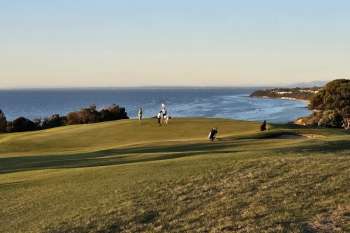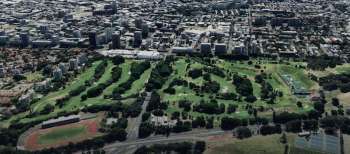Mission Possible - A look at China's ever expanding Mission Hills
Nothing in China surprises anymore. When it comes to golf bigger is better, and now the biggest is getting even bigger. A few years back the Mission Hills Golf Resort was officially endorsed by the Guinness Book of World Records as being the largest in the world, thanks to its 12 courses, which are spread across three properties in close proximity to Shenzhen, near Hong Kong. In late 2010 a new Mission Hills Resort opened, this time in Haikou on the southern Chinese holiday island of Hainan. Again there will be 12 golf courses, with 10 already finished and in play. Unlike the previous resort, however, this one has more than just sheer size on its side.
Despite what would be best described as modest golf offerings, the original Mission Hills resort has been extraordinarily popular with both local and foreign golfers. Perhaps it’s a curiosity, but thousands of visitors from all corners of the globe have taken the 45-minute shuttle from Hong Kong to Shenzhen in recent years to visit the resort and see what all the noise is about. Unfortunately it’s mostly about size, with the ten courses ‘co-designed’ by celebrity golfers, such as Annika Sorenstam, David Duval, Jumbo Ozaki and Vijay Singh, generally kept in good condition but a long way behind the quality of golf available at comparable Australian resorts. The Norman Course, designed while Bob Harrison and Harley Kruse were still involved in Greg Norman’s business, is a good track as is the original World Cup course, which was built by Nicklaus Design. The other ten were actually routed, ghost-designed, planned and constructed by Brian Curley, from the American team of Schmidt Curley, who are now responsible for all 12 of the new Mission Hills Haikou courses.
As with most golf developments in China, the construction of the Haikou Resort happened at break-neck speed, despite the fact the entire property was situated atop black volcanic lava rock. The first ten courses were completed in less than three years with the tenth, a rather ambitious quasi-links known as Shadow Dunes, taking just six months to be shaped, grassed and ready for play. When you consider the material that needed to be cleared to build these courses, and the amount of soil brought onto the site to cap the golf holes and allow the grass to grow, such schedules seem incredible.
Aside from the effective contrast between the lush green colours of the golf holes and the dramatic black rock of the surrounding areas, what works best about Mission Hills Haikou is the fact that it boasts more natural golf undulations than at Shenzhen, and that it allows you to experience virtually every architectural style of golf course known to the game. Whether it’s the demanding tournament-ready tests of Blackstone or Lava Fields, the old-school, turn-of the-century American style Vintage course, the links-like Shadow Dunes layout or the Pete Dye-inspired Stone Quarry or Melbourne-inspired Sandbelt Trails, there is no end to the golfing variety on offer here. There are also two unique par three courses, one called Double Pin that features really severe greens and both an easy and difficult flag on each hole, and the other known as Stepping Stone, which is full of picturesque all-carry shots and about as fun to play as any short course in the world.
Most visitors will want to tackle the full courses, however, and the good news for those underwhelmed by Shenzhen is that the quality available, design-wise, in Haikou is a significant improvement. As you might imagine, when one architectural company is asked to build ten courses, and quickly, there is certain to be the odd problem area, but thankfully the best golf here is terrific. The most obvious highlights are the two tournament tests, Blackstone and Lava Fields, which were given the best bits of land on the property and also the broadest golfing corridors. While they have their differences, both layouts feature sweeping ground undulations, jagged bunker shapes, sharply contoured green complexes and a number of dramatic carries across forests of exposed volcanic rubble.
Blackstone is known here as the A Course, and is certainly the most daunting test from the tees and around the greens. The course hosted the unique Mission Hills Star Trophy event late in 2010, when invited golf professionals like Greg Norman, Colin Montgomerie, Annika Sorenstam and winner Lorena Ochoa played a specially modified Pro-Am style tournament alongside celebrities such as Hugh Grant, Catherine Zeta-Jones, Michael Phelps and others. Highlights of the Star Trophy play on a continual loop throughout the resort, and provide a nice preview to the Blackstone layout for those preparing to tackle it during their stay. Better holes on the front side include the all-carry par threes, the strategic double-dogleg par fives and one-offs like the long par four 4th, with its wonderful cross-ravine approach shot. The back nine is a little less consistent than the front, but the falling one-shot 11th and spectacularly bunkered rising 14th are both terrific. Sadly the finish isn’t perfect, as zoning issues forced Curley’s original closing holes to be re-routed around a former farming area and necessitated the addition of a sizeable lake. The right bending par five 18th is an effective closer, but the 16th and 17th aren’t ideal as they deviate from a consistent theme across the rest of the holes to provide options and choices for all skill levels.
Lava Fields, by contrast, has a much more uniform feel across all 18 holes, and is also more forgiving thanks to its generous fairway landing areas. This fairway width is important, as it allowed Curley to use angles and options to create a series of strategic golf holes that are exciting and playable for golfers of varying ability. Like his mentor Pete Dye, Curley has an artist’s eye for green settings and on each course at Mission Hills Haikou are at least a couple of standout par threes. Lava Fields is no different, but it also boasts the best short par four Curley has designed in China - the 6th, which is a downhill teaser that rewards those able to aim their drive directly at the green and flirt with sand and rock along the tighter right hand side. Other standouts on Lava Fields include beautifully bunkered right-bending par fours at the 3rd and 5th, the double dogleg par five 12th and the stunning elevated approach shot into the 16th green. Despite being built as quickly as the other courses at this resort, both Blackstone and Lava Fields were clearly the priority layouts and seemingly given more attention during the planning and design stages. There was also less interference here on design from management, which was crucial.
The same cannot be said for The Vintage Course, which would be the clear number three here were it not for some rather unfortunate ‘improvements’ made after completion. Flatter and more open than the other courses when it first opened, management apparently felt that it lacked challenge and glamour and insisted the design team add more bunkers to the course. As construction was already completed and beneath was hard rock, this meant traps built on top of the ground – some ending up in the shape of volcanos, others as snakes or with chocolate drop mounds. Along with Stone Quarry, The Vintage works because it provides an insight into popular styles of US design for those who haven’t golfed stateside. The course was built as a tribute to the golden age design’s of pre-WWII America, when men like C.B. Macdonald and Seth Raynor were using geometric shapes to recreate the great British and European holes. Wacky bunker shapes and donut greens really have no place on a course like this, and on holes that are otherwise outstanding. Among the highlights at Vintage are some wonderfully pitched par threes, a number of bold plateau greens and replica putting contours and heavily undulating par fours like the 5th, 6th and 7th.
The Stone Quarry is a completely different beast, as it aims to pay homage to the extravagant architecture of modern day icon Pete Dye. Complete with endless sleepered bunkers, cross-quarry par threes and outrageously tiered putting targets, this is a fun layout that Dye himself might well be quite proud of. There are six par threes in total, and a number of ‘gettable’ par fours and fives, making it possible for those on top of their game to score well on Stone Quarry. As is a common theme throughout the resort, there are also a number of head-scratcher holes, none more obvious that the mid-length 13th with its triple-decker greenside volcano-shaped bunker, timber-paneled fairway paths and skinny collapsing target.
For Australian golfers the other layout of interest will be Sandbelt Trails, which is so named because it’s flashed sand-faced bunkers are said to resemble the traps on Melbourne’s famous Sandbelt courses. The tropical vegetation, lava rock, cart paths and night lights spoil any authentic Sandbelt feel the course might have had, but in isolation the holes themselves are not bad. Unfortunately they aren’t great either, and were they designed to mimic some of Melbourne’s best holes, rather than just copy their bunker style, this might have been a real highlight.
Of the remaining courses here, the most notable is the audacious Shadow Dunes, which is a large-scale concept course built by dumping large piles of dirt onto the rock and shaping it into believable sand hill formations. Complete with lumpy fairways, endless humps and hollows, heavy putting undulations and even a triple green played from three different directions, this is sure to become one of the most popular layouts at the resort.
One suspects the other really popular creation will be the forthcoming Icon Course, which will include a par three, four and five designed by the winner of a ‘design your own golf holes’ competition run by Mission Hills and architect Brian Curley. Coupled with the ‘armchair designer’ holes are a number shaped by Curley to resemble random, inanimate objects. Curley claims the Icon Course will be the ‘wildest thing ever done; almost full-scale mini golf.’ He adds that, ‘with the marketplace looking for variety, purists may cringe but I anticipate it will be madly popular and I am looking forward to pushing the “fun” buttons.’
There is no doubt that some readers will find the idea of mass produced golf quite distasteful, but those curious about China and eager to experience something completely different should consider a trip to Haikou to sample what will soon by the world’s equal largest golfing cluster. If full-scale mini golf doesn’t appeal you can always leave the Icon Course off your itinerary, and focus instead on the tracks mentioned above that take your fancy. Meadow Links and The Preserve are the other full-length courses available to play, and each has enough quality to please the discerning visitor.
While getting to the Haikou resort requires an additional flight, it’s only an hour in the air from Shenzhen or Hong Kong and a far easier sell on the non-golf partner than the older resort thanks to a dizzying array of additional family-friendly amenities. Beyond the soon-to-be dozen golf courses, is a luxurious 5-star hotel, Asia’s largest health spa and a superb collection of western and eastern restaurants. There are also fantastic kid-friendly leisure and aquatic facilities, including water slides, a lagoon pool with lazy river and a range of child care services such as playrooms, games areas and even special bakery cooking classes.
Darius Oliver, Architecture Editor
Back to NewsMore News
Report reveals golf's $3.3 billion contribution to Australia
AGIC report reveals total annual benefits to the Australian community, economy and environment from golf.
Cape Wickham Links – The Inside Design Story
Co-designer Darius Oliver reveals the truth behind the design of Australia’s premier modern golf course
Min Woo Lee signs up for Aussie PGA title defence
Reigning champion locks in the defence of his title at Royal Queensland Golf Club in November
Have your say on the future of Moore Park Golf
Golfers unite – another one of our cherished public access golf courses is under threat




